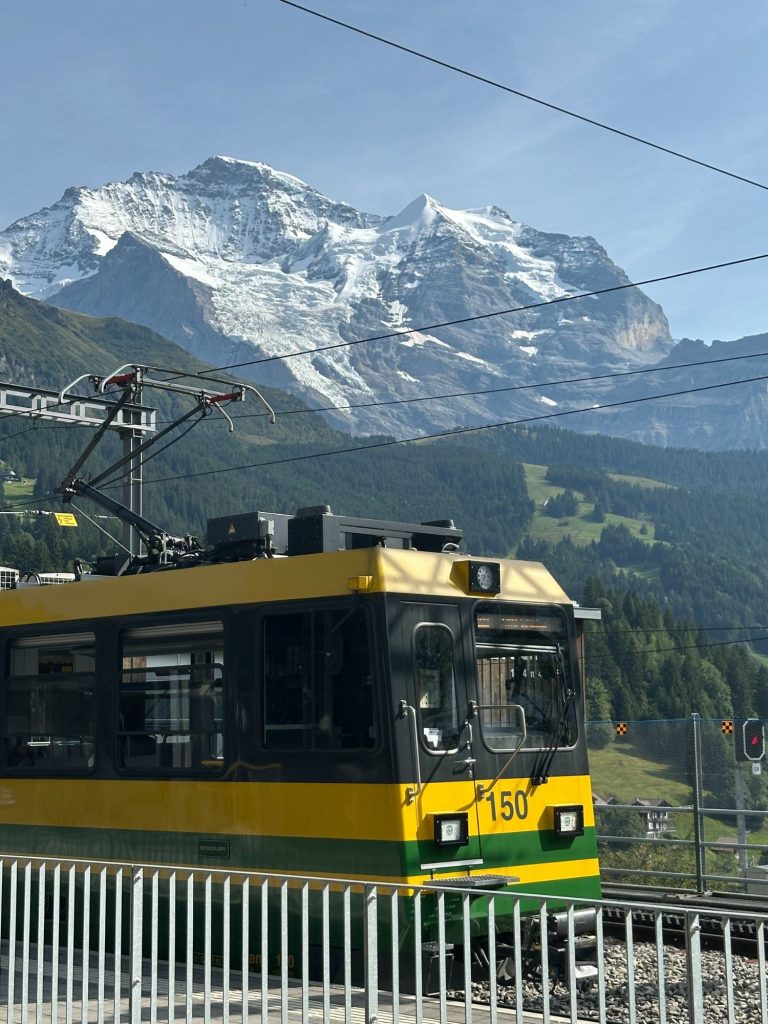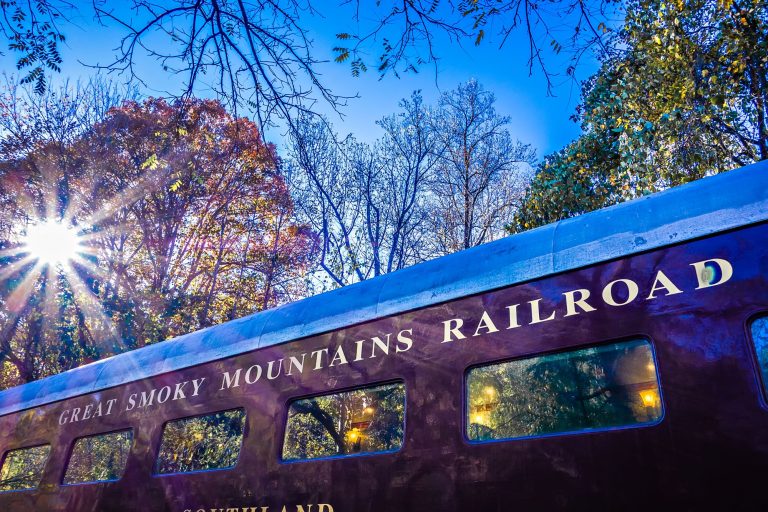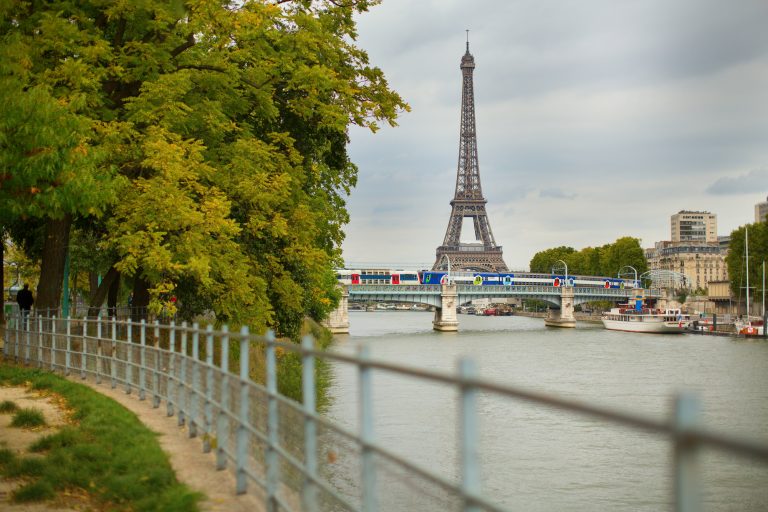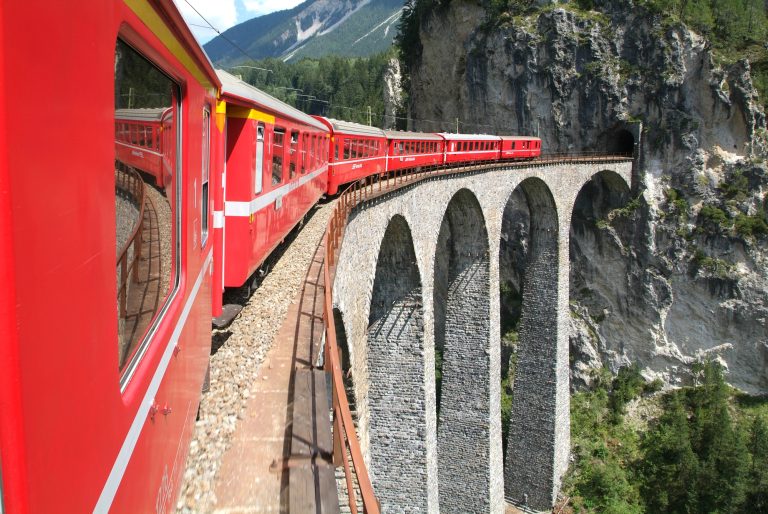Switzerland is known for its epic mountain views, pristine lakes, and charming towns, and the best way to explore it all is by train.
With one of the most efficient and scenic rail networks in the world, Switzerland offers unforgettable journeys for every type of traveller, whether you’re visiting for the first time or you’re a seasoned rail lover.
Whether you’re planning a once-in-a-lifetime adventure or simply want to experience some of the most popular train journeys in Europe, these ten train journeys are some of the most iconic and breathtaking in the country.
I’ve spent hours researching these routes while planning my own trip and have brought together the most scenic and popular options to help you decide which ones to include in your itinerary.
From famous panoramic rides to historic mountain railways, these are the train journeys that regularly top the great railway journey lists — for good reason.
1. Glacier Express
Route: Zermatt to St. Moritz
Journey Time: Around 8 hours
Distance: 291 kilometres
Covered by Swiss Travel Pass: Yes (reservation required)
Often called the slowest express train in the world, the Glacier Express is one of Switzerland’s most famous and scenic train journeys. Travelling between the mountain resorts of Zermatt and St. Moritz, this all-day ride takes you across 291 kilometres of stunning alpine landscape, passing through 91 tunnels and over 291 bridges.
Along the way, you’ll glide past deep gorges, snow-covered peaks, mountain villages, and the impressive Landwasser Viaduct — one of the most photographed spots on the route. The panoramic carriages offer floor-to-ceiling views, so there’s no need to jostle for a window seat.
Despite the length of the journey, it’s anything but boring. You can order lunch to your seat, listen to commentary through the on-board app, and simply sit back and enjoy the ever-changing landscape.
Why It’s Worth It:
This is a true once-in-a-lifetime train ride that lets you experience Switzerland’s alpine beauty in one seamless, slow-travel route. It’s luxurious without being inaccessible — and ideal for both seasoned travellers and first-timers.
Travel Tips:
- Seat reservations are mandatory and can sell out well in advance, especially in summer and winter.
- The journey can be done in either direction. Starting in Zermatt offers a gradual build-up of scenery, while ending in Zermatt gives you a grand finish.
- If you’re short on time, you can take a partial route — for example, Zermatt to Chur — and still see some of the most scenic stretches.
Official Site:
www.glacierexpress.ch
2. Bernina Express
Route: Chur to Tirano (Italy)
Journey Time: Around 4 hours
Distance: 144 kilometres
Covered by Swiss Travel Pass: Yes (reservation required)
The Bernina Express is another iconic scenic journey, and arguably one of the most spectacular train rides in the world. It connects Chur, Switzerland’s oldest city, with the Italian town of Tirano, travelling across the UNESCO World Heritage-listed Bernina Line.
Along the way, the train climbs to over 2,200 metres above sea level, winding through the Alps past glaciers, turquoise lakes, mountain peaks, and remote alpine villages. One of the most famous moments is crossing the Landwasser Viaduct, a dramatic curved bridge set against a cliff face. Another highlight is the Brusio Spiral Viaduct, where the train loops in a full circle to descend into the valley.
The scenery changes dramatically as you travel — from snow-covered mountain passes to palm-lined streets as you arrive in Italy. It’s a surreal transition that makes this journey feel truly unique.
Why It’s Worth It:
This route combines jaw-dropping alpine landscapes with fascinating engineering, all in just four hours. It’s also one of the only trains in the world that connects glaciers to palm trees — without you ever needing to leave your seat.
Travel Tips:
- Reservations are required for panoramic carriages, especially in peak seasons.
- Sit on the right-hand side when heading south from Chur to Tirano for the best views.
- If you’re travelling on a budget, regional trains run the same route and offer similar views without the reservation fee.
- Once in Tirano, you can continue on to Lake Como or Milan by regional train.
Official Site:
www.rhb.ch/en/panoramic-trains/bernina-express
3. GoldenPass Line
Route: Lucerne → Interlaken → Zweisimmen → Montreux
Journey Time: Around 5.5 hours (can be split into stages)
Distance: Approx. 190 kilometres
Covered by Swiss Travel Pass: Yes (no reservation required for standard trains; optional for panoramic or Belle Époque coaches)
The GoldenPass Line is a beautiful multi-stage journey that connects central Switzerland to the shores of Lake Geneva, passing through some of the most picturesque scenery in the country. It’s ideal for travellers who want to see a variety of landscapes in one go — from lakes and forests to alpine peaks and vineyard-covered hills.
The route begins in Lucerne and continues to Interlaken, then onto Zweisimmen, before descending into Montreux with sweeping views over Lake Geneva. You can ride the full route in a day or break it up with overnight stops in places like Interlaken, Gstaad, or Montreux.
One of the highlights is the option to ride in a Belle Époque carriage, styled like a 1930s luxury train with wood-panelled interiors and velvet seats. There are also modern panoramic trains with oversized windows for uninterrupted views.
Why It’s Worth It:
This is a fantastic all-rounder — accessible, flexible, and packed with stunning views. It’s perfect for anyone who wants a scenic but relaxed train ride without going too remote or high-altitude.
Travel Tips:
- No reservation is required for standard trains, but panoramic and Belle Époque carriages can be reserved for a small fee.
- The line is fully covered by the Swiss Travel Pass.
- Consider breaking up the trip with a stay in Interlaken or Montreux to explore more at your own pace.
- If you’re short on time, the Zweisimmen to Montreux leg offers some of the best scenery.
Official Site:
www.goldenpass.ch/en
4. Gotthard Panorama Express
Route: Lucerne (by boat) → Flüelen → Lugano (by train)
Journey Time: Around 5.5 hours (2.5 hrs by boat + 3 hrs by train)
Distance: Approx. 180 kilometres
Covered by Swiss Travel Pass: Yes (including boat ride)
The Gotthard Panorama Express is one of Switzerland’s most unique journeys, combining a peaceful cruise across Lake Lucerne with a historic train ride through the heart of the Swiss Alps. It’s an ideal choice if you’re looking for a slower, more immersive way to explore Switzerland’s landscapes and railway heritage.
The journey begins in Lucerne with a scenic steamboat ride across Lake Lucerne, passing dramatic fjord-like cliffs and storybook villages. At Flüelen, you transfer to the panoramic train, which takes you on the historic Gotthard route through spiral tunnels, deep gorges, and charming towns — all the way to the sun-drenched Italian-speaking region of Ticino.
Unlike the newer Gotthard Base Tunnel (which is fast but mostly underground), this older route is all about slow travel and storytelling. Panoramic carriages include an onboard travel guide and large windows for uninterrupted views.
Why It’s Worth It:
This is a journey as much about history and experience as it is about scenery. The blend of boat and train makes it feel like two adventures in one, and it’s perfect for anyone curious about Swiss transport history.
Travel Tips:
- Operates from mid-April to late October only.
- Seat reservations are required for the panoramic train (but included with some rail passes).
- The boat ride is just as much of a highlight — sit on the top deck for the best views.
- Great as a day trip or as part of a longer route toward Ticino or Italy.
Official Site:
www.sbb.ch/en/leisure-holidays/travel-in-switzerland/train-cruises/gotthard-panorama-express.html
5. Voralpen Express
Route: Lucerne → St. Gallen
Journey Time: Around 2 hours 15 minutes
Distance: Approx. 125 kilometres
Covered by Swiss Travel Pass: Yes
The Voralpen Express is one of Switzerland’s best-kept secrets. Connecting the central lakeside city of Lucerne with the eastern cultural hub of St. Gallen, this route takes you through a picture-perfect mix of lakes, forests, rolling hills, and traditional Swiss villages.
You’ll travel through the lesser-known pre-Alps region, where the mountains are gentler but no less scenic. Think lush green pastures, wooden chalets, and serene lakes that reflect the sky like glass. It’s a quieter journey than the Glacier or Bernina Express, but that’s part of its charm — you’ll often find fewer tourists and more locals on board.
One of the highlights is the spectacular Sitter Viaduct, Switzerland’s highest railway bridge, standing at 99 metres tall. You’ll also pass Lake Zurich’s upper end, and the journey finishes in St. Gallen, known for its baroque Abbey Library and textile history.
Why It’s Worth It:
This is a fantastic option if you want beautiful scenery without needing a seat reservation or extra cost. It’s also ideal for slow travel fans or those building a custom itinerary across Switzerland.
Travel Tips:
- No reservations needed — just hop on and go.
- Ideal for pairing with a visit to St. Gallen, Appenzell, or Lucerne.
- This is a regional route, so standard Swiss trains run frequently in both directions.
Official Info:
While there’s no dedicated panoramic website, SBB lists route details and schedules here:
www.sbb.ch/en
6. Luzern–Interlaken Express
Route: Lucerne → Interlaken
Journey Time: Around 2 hours
Distance: Approx. 98 kilometres
Covered by Swiss Travel Pass: Yes
The Luzern–Interlaken Express is a gorgeous gateway into the Bernese Oberland, one of Switzerland’s most breathtaking regions. This two-hour journey links two of the country’s most popular destinations, taking you past glittering lakes, over dramatic bridges, and through tunnels carved into mountainsides.
A standout feature is the Brünig Pass, where the train climbs steeply using a rack-and-pinion system, offering sweeping views of valleys and forests along the way. You’ll also skirt the edges of Lake Lungern and Lake Brienz, whose turquoise waters are some of the most photogenic in Switzerland.
Because this route is part of the GoldenPass Line, the carriages are designed for scenic travel, with wide windows and comfortable seating. It’s a brilliant choice for travellers heading toward Interlaken, Lauterbrunnen, Grindelwald, or the Jungfrau Region.
Why It’s Worth It:
This route is perfect for first-time visitors heading into the heart of the Alps. The landscapes are stunning from start to finish, and it’s a seamless way to connect two major hubs while enjoying panoramic views along the way.
Travel Tips:
- No reservation needed, but sit on the right-hand side for the best lake views heading toward Interlaken.
- If travelling with luggage, this train has good storage areas and is easy to board.
- Combine with a boat ride on Lake Lucerne for an extra scenic morning before you board.
Official Info:
www.sbb.ch/en
7. Jungfrau Railway
Route: Interlaken → Jungfraujoch (via Lauterbrunnen or Grindelwald)
Journey Time: Around 2 hours from Interlaken
Altitude: 3,454 metres (Top of Europe)
Covered by Swiss Travel Pass: Partially (discounted fare)
A true bucket-list experience, the Jungfrau Railway takes you all the way to Jungfraujoch, known as the “Top of Europe.” At 3,454 metres above sea level, it’s the highest railway station in Europe, perched between the mighty peaks of the Jungfrau, Mönch, and Eiger mountains.
The journey begins in Interlaken and continues via Lauterbrunnen or Grindelwald on the Wengernalpbahn, a historic cogwheel railway that climbs to Kleine Scheidegg.

Here, you’ll change to the Jungfraubahn, another cogwheel line that tunnels through the heart of the Eiger itself. Along the way, the train pauses at the Eigerwand and Eismeer stations, each with panoramic viewing windows cut directly into the rock, offering surreal glacier views from inside the mountain.
At the summit, you can wander through the Ice Palace, step out onto the Glacier Plateau, and marvel at sweeping views over the Aletsch Glacier, the longest glacier in the Alps. On clear days, you can even see as far as France and Germany.
Why It’s Worth It:
This is one of Switzerland’s most iconic train journeys, yes, it’s pricey, but the combination of world-class engineering, breathtaking alpine scenery, and high-altitude adventure makes it unforgettable.
Travel Tips:
- Check the weather before you go, clear days make all the difference.
- Save with discounts — the Swiss Travel Pass offers reduced fares, and early-bird tickets can help lower the cost.
- Dress warmly — even in midsummer, temperatures at the summit hover around freezing.
- Scenic tip: Travel up via Lauterbrunnen and return via Grindelwald (or vice versa) to experience two completely different sides of the Bernese Alps.
Official Info & Tickets:
www.jungfrau.ch
8. Gornergrat Railway
Route: Zermatt → Gornergrat
Journey Time: 33 minutes one way
Altitude: 3,089 metres
Covered by Swiss Travel Pass: Partially (discounted fare)
The Gornergrat Railway is a short but spectacular cogwheel train ride that climbs from car-free Zermatt to the summit of Gornergrat, offering some of the very best views of the Matterhorn.
In just over half an hour, the train ascends more than 1,400 metres, winding through alpine forests and past rocky cliffs before reaching a dramatic mountain ridge at over 3,000 metres. The panoramic viewing platform at the top offers a jaw-dropping 360-degree view, including the Monte Rosa Massif and 29 peaks over 4,000 metres.
Unlike the Jungfrau Railway, you don’t have to plan this trip too far in advance — you can show up, hop on, and go. It’s a flexible and rewarding excursion, especially if you’re staying in Zermatt.
Why It’s Worth It:
The Gornergrat is the best place to see the Matterhorn, full stop. It’s also one of the most accessible high-altitude trains in Switzerland, and the journey up is just as scenic as the destination.
Travel Tips:
- Go early or late in the day for the best light and fewer crowds — sunrise and golden hour are magical up here.
- No seat reservations needed, but aim for a window seat on the right-hand side going up.
- You can hike partway down if you’re up for a bit of adventure (trails from Rotenboden are especially scenic).
Official Info:
www.gornergratbahn.ch
9. Rigi Bahn (Mount Rigi Railway)
Route: Vitznau or Arth-Goldau → Rigi Kulm
Journey Time: Around 30–45 minutes
Altitude: 1,798 metres
Covered by Swiss Travel Pass: Fully included
Known as the “Queen of the Mountains,” Mount Rigi is one of the most beloved day trips in Central Switzerland — and getting there on Europe’s first-ever mountain railway makes it all the more special.
The historic cogwheel trains depart from either Vitznau (since 1871) or Arth-Goldau, winding their way up through lush meadows and traditional alpine villages to reach the summit at Rigi Kulm. On clear days, you’ll be rewarded with panoramic views over Lake Lucerne, Lake Zug, and even the distant Alps of Bern and Valais.
This journey is especially popular with locals and ideal if you’re based in Lucerne, as it’s easy to combine with a boat cruise across the lake. You can even turn it into a full loop by arriving in Vitznau by boat and returning via Arth-Goldau by train.
Why It’s Worth It:
Rigi isn’t the tallest mountain in Switzerland, but it’s one of the most accessible and charming. The combination of lakes, villages, and views makes this a classic Swiss experience — and it’s all included with the Swiss Travel Pass.
Travel Tips:
- Take the boat from Lucerne to Vitznau for a truly scenic start to the day.
- Weekdays are quieter, especially in summer — weekends can get busy.
- Combine your trip with hiking or picnicking on one of the easy summit trails.
Official Info:
www.rigi.ch
10. Schynige Platte Bahn
Route: Wilderswil → Schynige Platte
Journey Time: 52 minutes
Altitude: 1,967 metres
Covered by Swiss Travel Pass: Fully included
The Schynige Platte Bahn is a nostalgic journey into the heart of the Bernese Oberland — both literally and in spirit. Operating since 1893, this charming vintage cogwheel train winds its way up from Wilderswil, near Interlaken, to the alpine plateau of Schynige Platte.
The train climbs steadily through forests and pastures, revealing ever-widening views of the Eiger, Mönch, and Jungfrau peaks. At the top, you’ll find a peaceful station with an alpine botanical garden, a restaurant, and walking trails with some of the most underrated views in the region.
It’s a quieter alternative to the more famous Jungfrau Railway — perfect for travellers looking to slow down, take in the scenery, and enjoy a touch of old-world charm.
Why It’s Worth It:
This ride feels like stepping back in time. The carriages are vintage, the pace is slow, and the views are absolutely stunning — all without the crowds you might find elsewhere in the Jungfrau region.
Travel Tips:
- Open mid-June to late October only — check the timetable before planning.
- Try to sit on the right-hand side going up for the best views.
- Don’t miss the Alpine Garden (free entry) with over 600 plant species.
Official Info:
www.jungfrau.ch/en-gb/schynige-platte
Final Thoughts
Switzerland truly sets the gold standard when it comes to scenic train travel. Whether you’re gliding past glacial lakes, climbing toward snow-covered peaks, or coasting through vineyard-covered hillsides, these ten routes prove that the journey really can be just as memorable as the destination.
If you’re planning a Swiss adventure, don’t forget to check out the Swiss Travel Pass — it covers most of the routes listed here and can make travelling around the country both easier and more affordable.
And if you’re hooked on the idea of exploring Switzerland by rail, keep an eye out for my next post featuring 5 unique train experiences — from cheese trains to open-air carriages, there’s so much more to discover.






